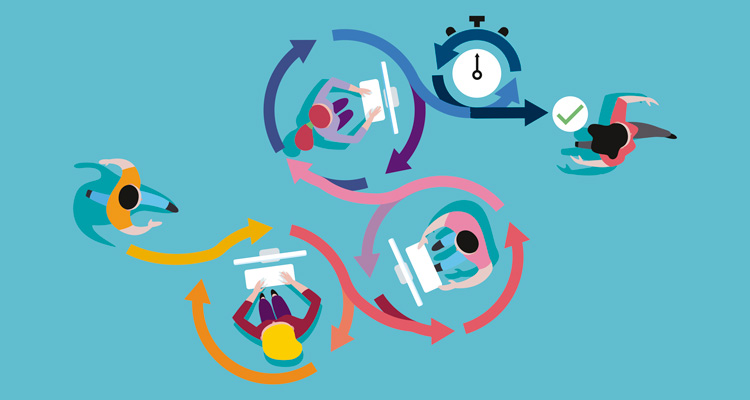For years, organizations have been applying Lean principles and Lean tools to align employees around why. It helps them make smarter decisions about how to invest their time, energy, and money with clarity and purpose to become an innovative, influential, and profitable organization.
When it comes to the question “why?”, it’s one we often forget to ask when starting a business, introducing a new product, or engaging in any major initiative. We generally know “how” we plan to do something or “what” we hope to accomplish and “when.” And we almost certainly know the “who” through customer research.
But seldom do we take the time to ask the “why” behind our actions. However, understanding the why of what we do provides context to our decisions. It provides the clarity and vision needed to keep resources, effort, and energy focused and on track. It motivates employees and maintains their faith in their ability to innovate, their company culture, and the bottom line.
We may not always know where we need to go – but if we know why we’re moving, we’re far more likely to move in the right direction.
Lean Tools Get us Closer to Understanding “Why”
Lean is a practical and intentional approach to breathing life into stale, fragile organizations simply by getting everyone on the same page. Once we internalize our why, Lean keeps us focused through a framework for continuously improving, treating people with respect, and relentlessly pursuing customer satisfaction as a primary indicator of success.
Lean is also something you do daily, aiming to always improve. It’s rooted in the idea that people want to do good work – and organizations want to provide environments that inspire them to do so. However, often individuals, teams, and entire companies are so entangled by the status quo – their existing processes, tools, ways of thinking, leadership styles – that they lose the ability to innovate. By practicing Lean, we can slowly unravel the complexity in our work and resume the flow of productivity and innovation.
The practice began in the 1950’s by the Toyota Production System to revolutionize manufacturing. However, unlike manufacturing, knowledge work is less tangible and predictable than products rolling down an assembly line. The value created from knowledge work is in the minds of workers, which presents a unique set of challenges and opportunities when applying Lean to disciplines like marketing, sales, and finance.
If you’ve ever considered implementing Lean to establish clarity in organization, the eBook, “Getting Started with Lean,” is meant just for you. Here’s a quick overview of the Lean principles and tools that allow you to better understand the “why.” Find them in greater detail by downloading the eBook today.
8 Guiding Principles of Lean
- Continuous Improvement: Continuous improvement is a commitment to always strive to be better – it’s a dedication to challenging the status quo to reduce waste in any organization.
- Optimize the Whole: Lean thinking teaches us that the whole is worth more than the sum of its parts. To create the most value with our limited resources, we have to optimize across our entire value stream.
- Eliminate Waste: Waste, in knowledge work, can be anything from context switching, to too much work in process, to time spent manually completing a task that could be automated.
- Build Quality In: As businesses grow, homegrown systems become limited. Lean companies set themselves up for sustainable growth by practicing the Lean principle of Building Quality In.
- Deliver Fast: The Lean principle of Deliver Fast by Managing Flow is based on the idea that the faster we can deliver bits of value to our customers, the sooner we can begin to learn from customer feedback.
- Create Knowledge: The Lean principle of Create Knowledge is related to the concept of Optimizing the Whole. A Lean organization is a learning organization – it grows and develops through analyzing the results of small, incremental experiments.
- Defer Commitment: The Lean thinking principle of Defer Commitment encourages organizations to make decisions at the last responsible moment, to continuously make decisions based on the most up-to-date, relevant, comprehensive information.
- Respect People: Lean thinking reminds us that the majority of the value created in organizations is in the heads of employees – and that in order to retain those employees, organizations have to create environments for employees to do their best work.
Getting Started
To initiate your Lean practice, start with a discussion about finding the why in what your organization does. This approach might be considered a bit abstract for more traditional leaders, so find a champion within your organization to help convince others.
From there, conduct a value stream mapping exercise to uncover how value flows through your team and your organization. We recommend Kanban, a visual workflow management tool created by Toyota. Kanban will help you analyze and optimize that process for value creation.
And then use that information as a basis to build a culture of experimentation. Failure is part of success. We all have to fail a few times before getting it right. The Lean approach embraces, and even celebrates failure as an opportunity for growth.
The eBook, “Getting Started with Lean,” covers several tools like Kanban to help you in your journey, such as:
- WIP Limits to limit your work in progress so you can move quickly and manage capacity
- Continuous delivery for sustainable workflows that get your products into the hands of your customers faster
- Pull System as an alternative to the traditional push system where employees blindly start work and push it onto our coworkers
Lean organizations respect their employees by giving them what they need to do good work. In return, employees do their best work in the best interest of the customer by continuously innovating and growing. They treat each other with respect by being transparent, communicative, and supportive to one another. And they stay committed to the company’s unified vision.
If Lean sounds like the right approach to your organization’s challenges, check out this eBook. And let us know how it helps you and your colleagues understand the why of your world.






